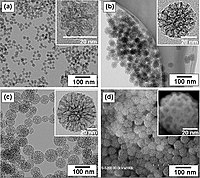
Photo from wikipedia
Abstract Non-noble metal Cd nanoparticles, as an efficient cocatalyst, are successfully constructed onto the surface of hexagonal CdS nanorods (CdS NRs) for the photocatalytic hydrogen evolution reaction by a facile… Click to show full abstract
Abstract Non-noble metal Cd nanoparticles, as an efficient cocatalyst, are successfully constructed onto the surface of hexagonal CdS nanorods (CdS NRs) for the photocatalytic hydrogen evolution reaction by a facile in situ chemical reduction approach based on a thermal treatment process. The in situ introduction of Cd can significantly improve the photocatalytic H2 production performance of CdS NRs in sodium sulfide and sodium sulfite aqueous solutions under visible light irradiation. The superior electrical conductivity of metallic Cd and the intimate interfacial contact between Cd and CdS NRs are suggested to account for the enhanced light absorption intensity, more efficient charge separation, and faster interfacial charge migration, resulting in the dramatically promoted photocatalytic H2 production activity. This work provides a new route for the in situ deposition of Cd nanoparticles onto CdS and other Cd-containing semiconductor photocatalysts with desired morphologies.
Journal Title: Applied Catalysis B: Environmental
Year Published: 2018
Link to full text (if available)
Share on Social Media: Sign Up to like & get
recommendations!